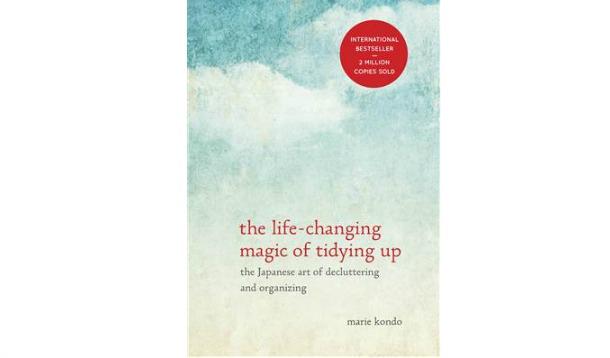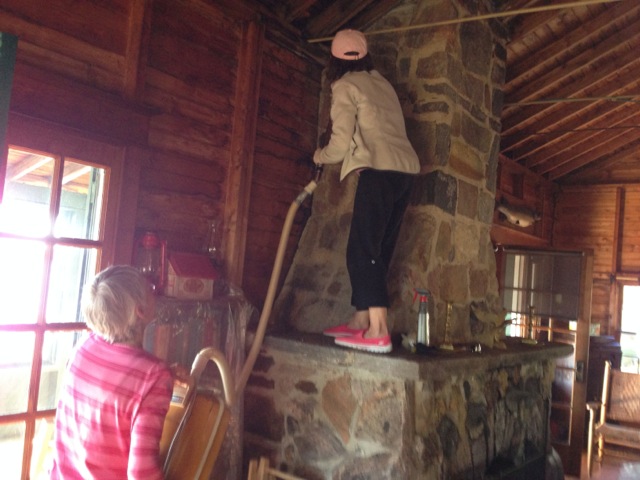
It is the time of year for change, resolutions, and order. For me this entails an endless quest for a neatly organized house.
My desire for such a home used to be based on a 50s notion that a good wife and mother should present a tidy abode. Now that I have cheerfully found other means of fulfillment, I realize that my need for order is likely psychological and should be prioritized.
For years I have noticed that for three hours every Wednesday, before the children return and following a visit from my housekeeper, I feel my most sane and mentally productive.
This dynamic oasis feels noticeably preferable to blistering anxiety ignited by being buried alive in household clutter.
As a traditional adult child, I choose to blame my psychological need for order on my mother’s side of the family. The Hindmarsh women have waged a ruthless war on filth and clutter for generations. There is no doubt that my grandmother has lived to be 96 on a steady regime of yoga, bran buds, grit, and vacuuming.

Sadly, it appears that my home organization genes were biologically dominated by my father’s Cadillac-driving, antiquing mother. In a past life I must have been the manager of a bunker or perhaps a squirrel.

My compulsion to stock-up often leads to multiple purchases of the same item, for fear of running out. I also habitually store things, “In case I might need them some day.”
A passion for kitsch, seasonal decor and deep empathy for unloved stuffed animals only worsens my plight.
When purging becomes inevitable, Catholic guilt about wasted money, the environment and feelings of sentimentality frequently derail my goals.
Since the health department has yet to darken our door, only minimal extractions have been required to date. This all changed December 2015 when there was less than an hour to find the mittens.

By January 1st, bursting with resolutions and drowning in crap, it was time to do better. I began by fleeing to HomeSense, a safe haven for both mild and severe procrastinators.
After exhaustively loading up on colourful space savers, Chapters beckoned for a strengthening latte and pile of decorating magazines.

Just beyond the front doors, Marie Kondo’s book, The Life-Changing Magic of Tidying Up was waiting for me. Seduced by the red tiny font and beautiful light blue jacket, I plunked down and read the whole thing.
Translated from Japanese, the author’s voice is immediately lovable. She is strict, smart, funny, and a teensy bit scary. I crave her friendship but would be terrified to let her near my stuff. The tone is sunny with noticeable airiness between the words.
Although over 200 pages, the book is a page-turner boiling down to a few rules surrounded with supporting arguments and tips for success.
Espousing her self-created KonMari Method, Kondo insists that we, “Start by discarding. Then organize your space, thoroughly, completely, in one go.” For an item to be granted asylum, it must spark joy when we touch it. Kondo insists that,
“A dramatic reorganization of the home causes correspondingly dramatic changes in lifestyle and perspective. It is life transforming.”
No need to give up wine either: “It’s a very strange phenomenon, but when we reduce what we own and ‘essentially ‘detox our house, it has a detox effect on our bodies as well.”
Unlike the immediate pull of most great reads, Kondo’s work creates skepticism first followed by enlightenment. Tales of wildly stuffing garbage bags and sneaking out her family’s belongings can be off-putting and make her seem nutty.
She quickly wins my allegiance by arguing that daily tidying is a complete waste of time, “If you tidy up in one shot, rather than little by little, you can dramatically change your mind-set.”
Kondo also claims that, “Storage experts are hoarders” and that, “those ‘storage solutions’ are really just prisons within to bury possessions that spark no joy.” Busted.
Throughout the book, Kondo offers excellent reasons why we can and should discard every item needlessly being held onto. What she says about the need to store unloved gifts is priceless, “The true purpose of a present is to be received. Presents are not ‘things’ but a means of conveying someone’s feelings.” She suggests that it is the thought and transaction that is special and not the item.
She calls me out for storing unwanted pink hand-me-downs in my younger daughter’s closet, even though I know she prefers her brother’s clothes and addresses my stockpile syndrome: “For people who stockpile, I don’t think there is any amount that would make them feel secure.”
Category by category she gives permission to discard papers, photos and pocketed hotel products. She then offers tips of how to store the things we adore.
Initially Kondo may appear merciless, but the deep respect she has for the things she loves and keeps, makes me want to hug my socks: “Possessions that have a place where they belong and to which they are returned each day for a rest are more vibrant.”
Wild with curiousity, I decide to test my possessions for sparks of joy. Reaching into the back of my closet to touch a beautiful pink cardigan I feel nothing but guilt. The sweater has not been worn in over a year because it is itchy and gives me a rash. Putting my hand on a pair of expensive black pants, faded to grey after a few washes, incites the same emotion. A lump inflates in my throat and the feeling is similar to enduring a relationship with the wrong person. Taking a deep breath, I reach for a wedding gift from my friend Natalie and smile with happiness. This crazy exercise works so well that I am afraid to touch the children!
Speaking of children, my companion Gayle’s kids were able to downsize their toy collection by utilizing the same techniques.
Disregarding Kondo’s book for being too extreme might make for missed opportunities. As grown-ups we have earned the right to take what we want from each experience and discard the rest. Strict compliance to the KonMari Method is unrealistic for our personal domestic carnival but I am grateful for permission to let go of things being kept for the wrong reasons. It makes sense that if we surround ourselves with items that bring us joy, not sadness and regret, we will automatically be happier.
Kondo’s endless garbage bags can be off-putting to the environmentally conscientious but recycling bins and trips to Value Village are easy substitutes. Her methods may also lead to future financial and environmental benefits as a clutter-free home encourages one to purchase less.
Thankfully, I think this book may have also chased the squirrel out of me. Buying in bulk makes financial sense for large households but I will never use 1,500 Q-tips before they turn to dust.
Freeing us from the need to keep an enormous book collection Kondo states, “The moment you first encounter a particular book is the right time to read it.” This logic feels perfect to me as I found hers when I was ready for help with my insurmountable mess.
So Happy 2016! It is time to mail the cards, empty the gift cupboard, burn the candles, and drink the good booze. May your path be clear, especially of Lego, and lead you to what you love.

A few weeks ago I overheard my husband bark at my daughter, “Just choose an outfit. It shouldn’t take this long!” My sweet tween flower was having a fashion crisis because finding the right outfit to feel safe and comfortable in at school was challenging her. Knowing that this situation was so much more complicated than creating a look, I sent him to feed the dog and took over.
It doesn’t take much to trigger the agonized feelings associated with being a tween girl. Unless you were one of those few floating goddesses, there is likely a bit of flinching involved when reflecting on your adolescence. I am sure that the road to manhood is equally bumpy but I have no point of reference.
I would argue that the years from ages 11 to 18 have the capacity to produce a gal’s most scarring memories and photos. We are so aware of our bodies and so is everyone else. Girls and boys are studying each other often with an undeveloped sensitivity chip. It is a time of crazy growth, and often in a physically unbalanced way.
A trip to the mall can easily become disheartening when children’s clothes don’t fit properly anymore and the women’s section is ill-suited to an adolescent body. Danger lurks in the hallways at school as one clothing malfunction could lead to major social upheaval. Being noticed for wearing a bra or not wearing one is equally devastating. One period-related mishap could make the sight of white shorts traumatizing for life. Modesty, identity, awkwardness and emerging sexuality collide and no two shapes are the same. Hormones raise tiny perceived physical imperfections to levels of epic travesty. Skin, hair, and underarms join the rebellion until muffled defeat is declared from under a duvet.
I have always adored the armor of my clothes and most moments in my 42 year history are mentally catalogued according to outfit.
Roller-skating was a breeze in red and white Dolphin shorts. George Michael and I can attest to their silky comfort. Speaking in church for the first time was made easier by a hot pink turtleneck, black pencil skirt, and matching patent polka dot shoes. Most of our grade eight family trip to Washington was spent looking down with love at my Converse high tops. And although I did once have to write a letter to my father, pleading my case for Guess Jeans, I don’t think my passion for fashion was driven by materialism.
I know I am not alone in this. Reflecting, I asked my cousin whether her Fame jeans, of middle school years, were white or red. She replied without missing a beat, “Both! I had white capris and red jeans.” This feat of recall is not small from a woman who claims she forgot to take her second son to the start of kindergarten.
Clothing continued to play an essential role in high school. Centennial C.V.I. was terrifying to me and divided, Breakfast Club style, into uniformed social groups. Wearing too much of another group’s look meant crossing lines into places where you weren’t wanted.
Part of what got me through those years was sharing clothes with my high school best friend. She was braver than I was and wearing her clothes made me feel protected. A silent message that said she belonged to me and I to her. This practice also resulted in me being stuck in her tapered army pants for a full, panicked forty minutes. We took turns wearing a white Roots sweatshirt until it became a stained and ripped map of memories. When she died seven years ago, her mother sent it to me because she knew its value. And while the ratty sweatshirt brings me comfort, I had to give away every single piece of the new outfit I bought for her funeral.
There is no doubt that life experiences have equipped me with enormous empathy for my daughter but I do often wonder if my perceptions of girl world are outdated.
I decided to seek the professional opinion of Rachel Simmons, co-founder of Girls Leadership and bestselling author of Curse of the Good Girl and Odd Girl Out. Having read and loved both books, I knew her to be an expert on young women today.
When asked if clothing still matters to girls, Simmons replied, “Yes. If you walk around any middle school everyone is dressed very uniformly. There is no denying that clothes are part of a girl’s identity.” However, is seems this reality is not necessarily a bad thing. “Clothing can be a nice tool to have at your disposal. What you wear can make you feel good about yourself and more comfortable when your brain is freaking out.”
Sadly, some things have changed. When I was a teen girl, our behavior wasn’t always demure but fashions were extremely modest. We partied in wool ski sweaters and oversized Levis. During our chat, Simmons and I shared memories of our respective beloved and oversized Benetton rugby shirts. My friend Jackie still swears that she felt her most vexing in high school wearing her new khakis, turtleneck and Cotton Ginny sweater.
Despite the rising embrace of girl power, Simmons shares that clothing for girls has actually become increasingly sexualized and revealing with fewer style choices available. It has also has become more acceptable for girls to dress sexually at a younger age. One has only to go shopping for a Halloween costume to illustrate this point.
Although I am hopeful that the return of grey work socks, baggy track pants and messy buns bodes well for the future, I feel it is important to plan for storms. Therefore I added to my research and compiled a list of tips to help all of us get our girls dressed and out the door feeling strong and brave.
That being said, Simmons also believes that is it okay teach girls that they still live in a world where women are judged by their looks and are not yet treated equally. “Instead of saying, ‘You can’t wear that!’ try ‘I am concerned that your clothing is sending a message.’ Instead of criticizing, try to give her a larger consciousness about the world in which she is getting dressed.”